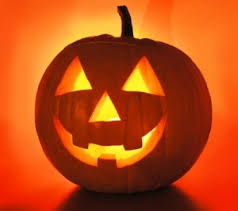
BEYOND HALLOWEEN 2009: HISTORY OF HALLOWEEN
source
http://news.nationalgeographic.com/news/2009/10/091031-halloween-2009-google-doodle-logo.html
Halloween's origins date back more than 2,000 years. On what we consider November 1, Europe's Celtic peoples celebrated their New Year's Day, called Samhain (SAH-win).
The night before Samhain—what we know as Halloween—spirits were thought to walk the Earth as they traveled to the afterlife. Fairies, demons, and other creatures were also said to be abroad.
Celtic Costumes
In addition to sacrificing animals to the gods and gathering around bonfires, Celts often wore costumes—probably animal skins—to confuse spirits, perhaps to avoid being possessed, according to the American Folklife Center at the U.S. Library of Congress.
By wearing masks or blackening their faces, Celts are also thought to have impersonated dead ancestors.
Young men may have dressed as women and vice versa, marking a temporary breakdown of normal social divisions.
In an early form of trick-or-treating, Celts costumed as spirits are believed to have gone from house to house engaging in silly acts in exchange for food and drink—a practice inspired perhaps by an earlier custom of leaving food and drink outdoors as offerings to supernatural beings.
(Beyond Halloween 2009: more on the first Halloween costumes.)
Christian Influence on Halloween
Samhain was later transformed as Christian leaders co-opted pagan holidays. In the seventh century Pope Boniface IV decreed November 1 All Saints' Day, or All Hallows' Day.
The night before Samhain continued to be observed with bonfires, costumes, and parades, though under a new name: All Hallows' Eve—later "Halloween."
Halloween Arrives in America
European immigrants brought Halloween to the United States, and the celebration really gathered steam in the 1800s, when Irish-American immigration exploded.
Anoka, Minnesota, may be home to the United States' oldest official Halloween celebration. Beginning in 1920, the city began staging a parade and bonfire.
Anoka historians say townsfolk wanted to curb Halloween pranks that loosed cows on Main Street and upended outhouses.
HALLOWEEN 2009
Business of Halloween 2009
2009 may be especially scary for Halloween retailers. The average consumer will spend less on the holiday in 2009 than he or she did in 2008, research shows. U.S. residents are expected to spend an average of $56.31 on Halloween in 2009, down from $66.54 last year.
Total U.S. Halloween 2009 spending is predicted to sag to $4.75 billion, about a billion dollars less than in 2008.
Upward of 15 percent [of the people surveyed] said they would either make a costume or use last year's costume, said National Retail Federation spokesperson Kathy Grannis.
What Average Americans Will Spend on Halloween in 2009
• Halloween Costumes: $20.75
• Halloween Candy: $17.99
• Decorations: $14.54
• Greeting Cards: $3.02
(Source: 2009 National Retail Federation survey.)
Some of last year's most popular costumes have also fallen out of favor, perhaps because of weariness with Washington politics.
Among adults, nurse costumes fell from number five overall to completely out of the top ten. "We are speculating that Americans might be sick of hearing about the health care debate, so nurses kind of slipped down the list this year," Grannis said.
"The same goes for politicians, who didn't even make the list. Last year they were all over the streets."
Grannis said pop culture played a major role in skyrocketing sales for both adult and child vampire costumes. The Twilight series, Vampire Diaries, and True Blood appear to have inspired plenty of would-be bloodsuckers this year.
Ten Most Popular Adults' Halloween 2009 Costumes
1. Witch
2. Vampire
3. Pirate
4. Clown
5. Wench/Tart/Vixen
6. Cat
7. Devil
8. Scary Costume/Mask
9. Athlete
10. Police Officer
Ten Most Popular Children's Halloween 2009 Costumes
1. Princess
2. Witch
3. Spider-Man
4. Pirate
5. Pumpkin
6. Vampire
7. Disney Princess
8. Star Wars Character
9. Tinker Bell
10. Batman
Hallmark Halloween
Americans give about 35 million Halloween greeting cards a year, with the most popular variety being grandparent-to-grandchild, Deidre Parks, a spokesperson for Missouri-based Hallmark Cards, told National Geographic News in 2008.
"The first Halloween cards that we can detect in the U.S. were produced in 1908," Parks said.
Halloween Sugar Rush
There are some 36 million potential trick-or-treaters (children aged 5 to 13) in the United States, according to the U.S. Census Bureau.
In 2007 the average American consumed 24.5 pounds (11 kilograms) of candy, much of it during the Halloween season, according to census data.
Great Pumpkins
Far from the pumpkin's native Central America, chilly Illinois produces more than 90 percent of U.S. pumpkins.
Across the U.S., farms grew 1.1 billion pounds of the fruit in 2007, according to the U.S. Department of Agriculture. Total value: about $117 million.
The current world record for biggest pumpkin was set in 2007 by a 1,689-pound (766-kilogram) monster grown in Rhode Island.
Earlier in 2009, though, Canton, Ohio, schoolteacher Christy Harp grew a behemoth pumpkin that, at 1,725 pounds (782 kilograms) is likely to shatter the existing official world record.
About 90 percent of a pumpkin's weight is from water. While growing, a champion pumpkin can add 40 pounds a day and reach roughly the size of a Volkswagen Beetle. (See "Giant Pumpkins 'Go Heavy' This Halloween.")
WITCHCRAFT AND WILD TALES
Do You Believe in Magic?










No comments:
Post a Comment